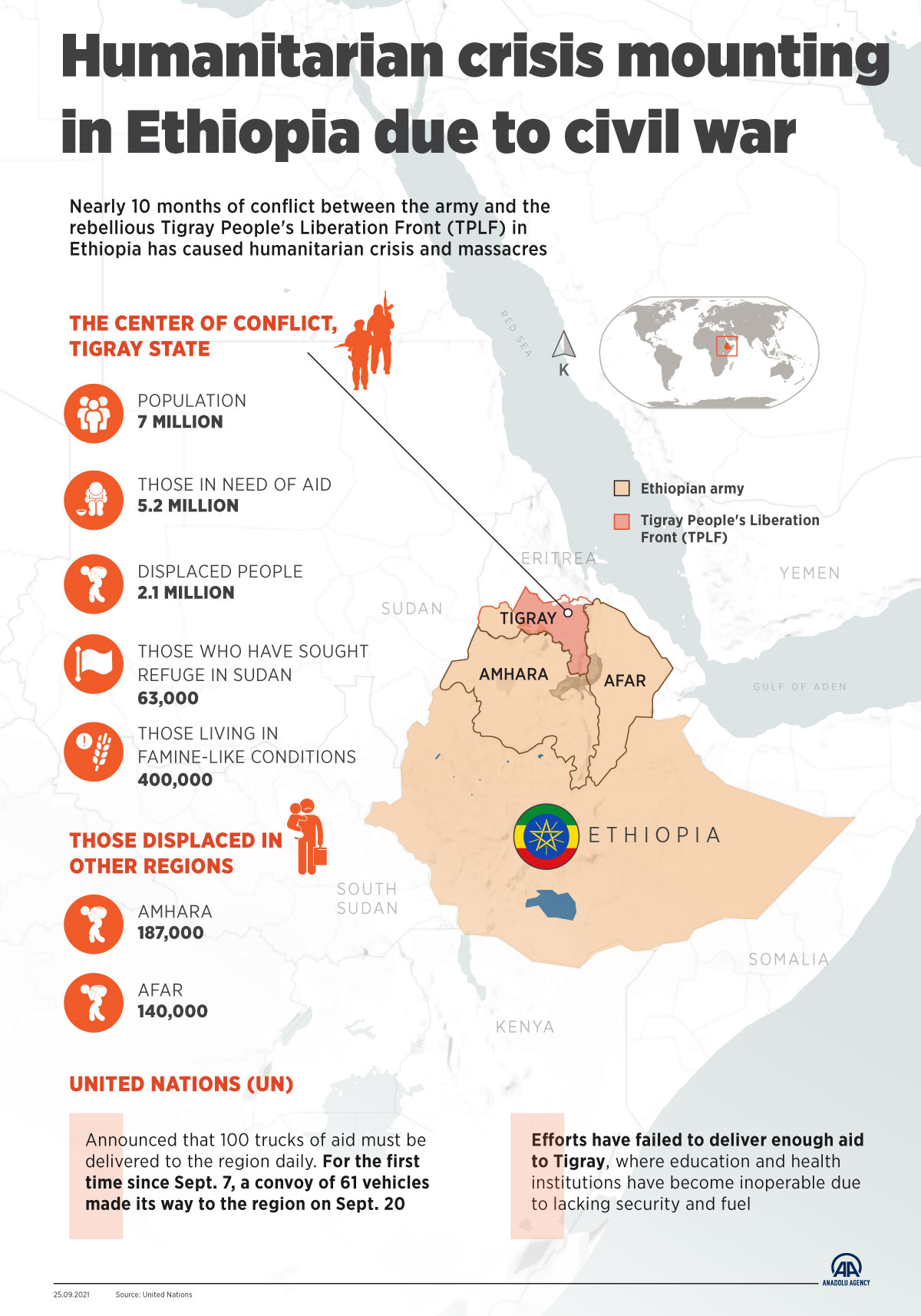Captured FN P90 being used by a Tigray fighter!!
You are using an out of date browser. It may not display this or other websites correctly.
You should upgrade or use an alternative browser.
You should upgrade or use an alternative browser.
Ethiopia's Tigray Conflict
- Thread starter Saithan
- Start date
Sad story of African conflicts.
Tigray threw ballistic missiles into Eritrea which provoked Eritreans into joining the conflict.
But somehow they are the victims. They even started this war because Tigrayans dont want to give their power and privledges up because Abiy Ahmed is a Oromo.
Residents in Ethiopia's blockaded Tigray starve to death
BY ASSOCIATED PRESS
NAIROBI AFRICASEP 20, 2021 10:51 AM GMT+3
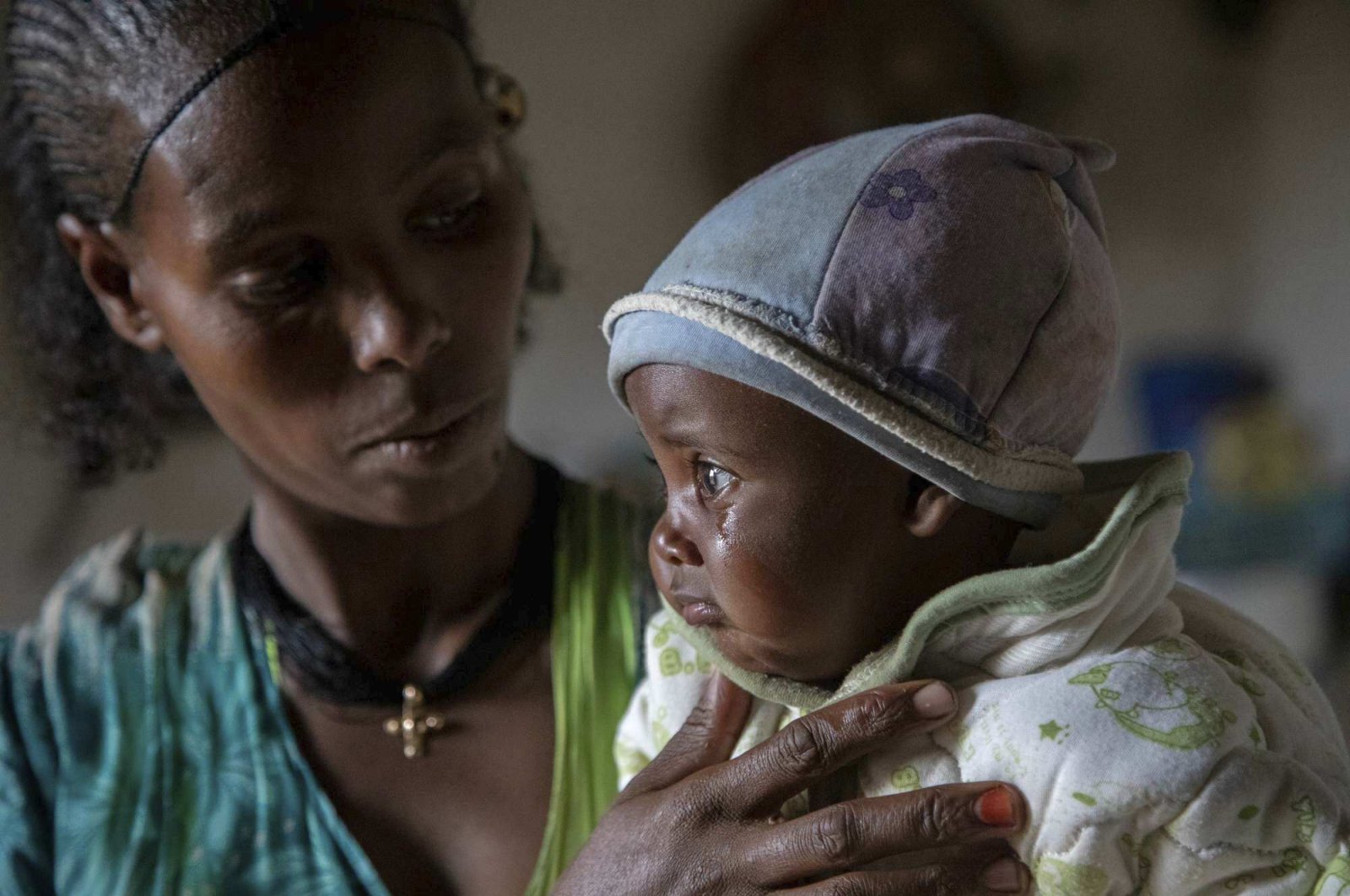
Ababa, 25, comforts her 6-month-old baby Wegahta, who was diagnosed as severely acutely malnourished, in Gijet, the Tigray region, northern Ethiopia, July 20, 2021. (AP Photo)
New photographs from the restricted Ethiopian region of Tigray revealed a catastrophic famine gripping the population and causing deaths as the U.S. and U.N. urge the country's government to lift the humanitarian aid blockade
In parts of Ethiopia's Tigray region, people are now forced to eat only green leaves for days. At a health center last week, a mother and her newborn, weighing just 1.7 pounds, died from starvation.In every district of the more than 20 where one aid group works, residents have starved to death. For months, the United Nations has warned of famine. Now internal documents and witness accounts reveal the first starvation deaths since Ethiopia's government in June imposed what the U.N. calls "a de facto humanitarian aid blockade.”
Forced starvation is the latest chapter in a conflict where ethnic Tigrayans have been massacred, gang-raped and expelled. Months after crops were burned and communities were stripped bare, a new cause of death has set in. The U.N. calls it the world’s worst hunger crisis in a decade.
"You are killing people,” Hayelom Kebede, the former director of Tigray’s flagship Ayder Referral Hospital, recalled telling Ethiopia's health ministry in a phone call this month. "They said, ‘Yeah, OK, we’ll forward it to the prime minister.’ What can I do? I just cry.”
Hayelom shared with The Associated Press (AP) photos of a few of the 50 children receiving "very intensive care” because of malnutrition, some of the first images to emerge from Tigray in months.

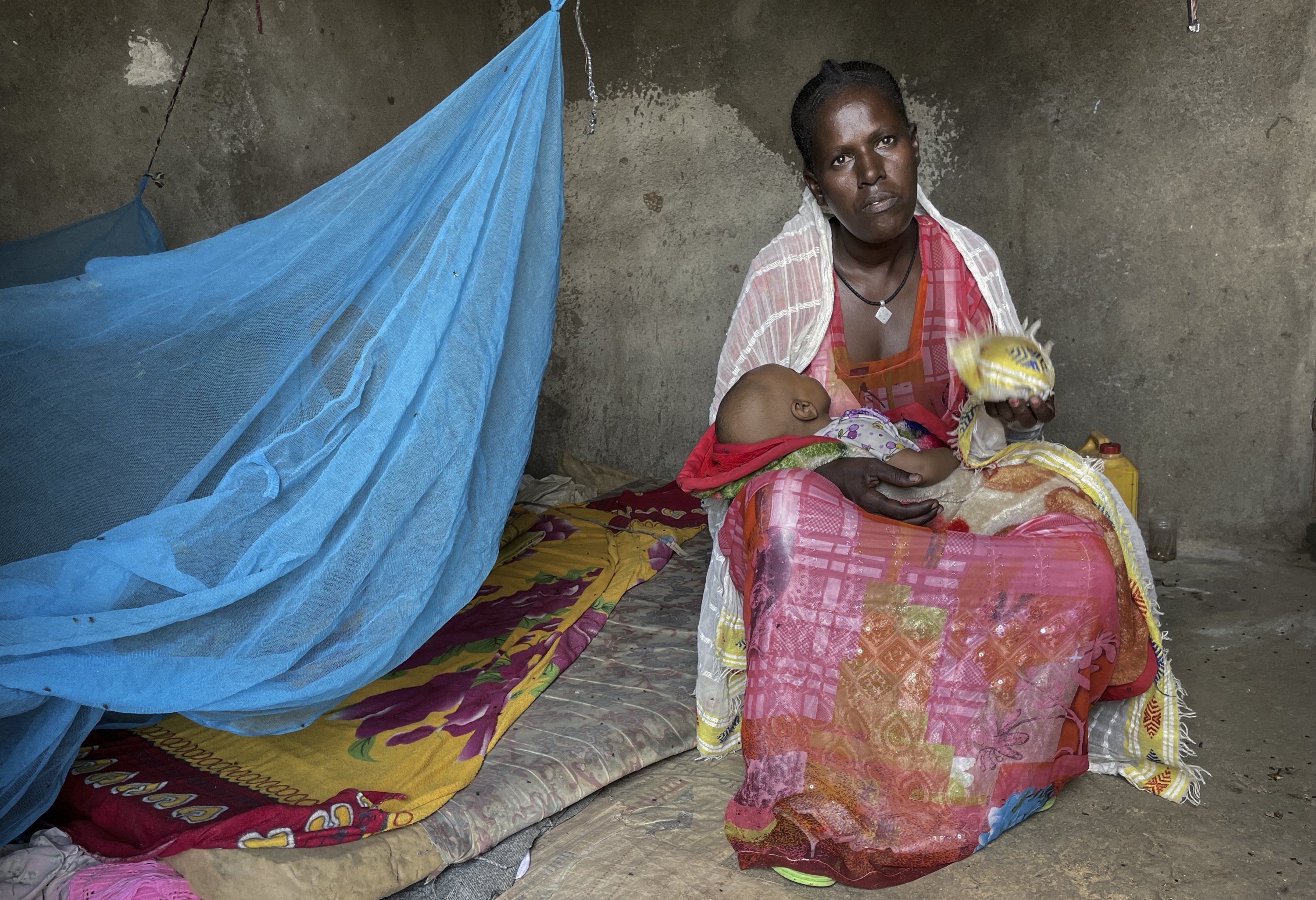
In one, a small child stares straight into the camera, a feeding tube in his nose, a protective amulet lying in the pronounced hollow of his throat.
The blockade marks a new phase in the 10-month war between Tigray forces and the Ethiopian government, along with its allies. Now the United States has issued an ultimatum: Take steps to stop the fighting and let aid flow freely, or new sanctions could come within weeks.
The war began as a political dispute between the prime minister, 2019 Nobel Peace Prize winner Abiy Ahmed, and the Tigrayans who had long dominated Ethiopia's repressive national government. In June, the Tigray forces fighters retook the region of 6 million people, and Ethiopia's government declared a cease-fire, citing humanitarian grounds.
Instead, it has sealed off the region tighter than ever. More than 350,000 metric tons of food aid are positioned in Ethiopia, but almost none of it can get into Tigray.
The government is so wary of supplies reaching the Tigray forces that humanitarian workers boarding rare flights to the region have been given an unusual list of items they cannot bring: dental floss, can openers, multivitamins and medications, even personal ones. The list, obtained by the AP, also banned means of documenting the crisis such as hard drives and flash drives.
Tigray has returned to darkness, with no telecommunications, no internet, no banking services and very little aid. Ethiopia's prime minister and other senior officials have denied there is hunger in Tigray. The government blames the Tigray forces and insecurity for troubles with aid delivery and says it has reduced the number of checkpoints that slowed convoys. It also has accused humanitarian groups of supporting the Tigray fighters. The prime minister’s spokesperson, Billene Seyoum, did not say when the government would allow basic services to the region.
The government "has opened access to aid routes by cutting the number of checkpoints from seven to two and creating air bridges for humanitarian flights," she said in a statement. However, medical supplies on the first European Union airbridge flight were removed during government inspection.
In the most extensive account yet of the blockade's toll, a humanitarian worker told the AP that deaths from starvation are reported in "every single” district of the more than 20 in Tigray where one aid group operates. The group had run out of food aid and fuel. The worker, like others, spoke on condition of anonymity for fear of retaliation.
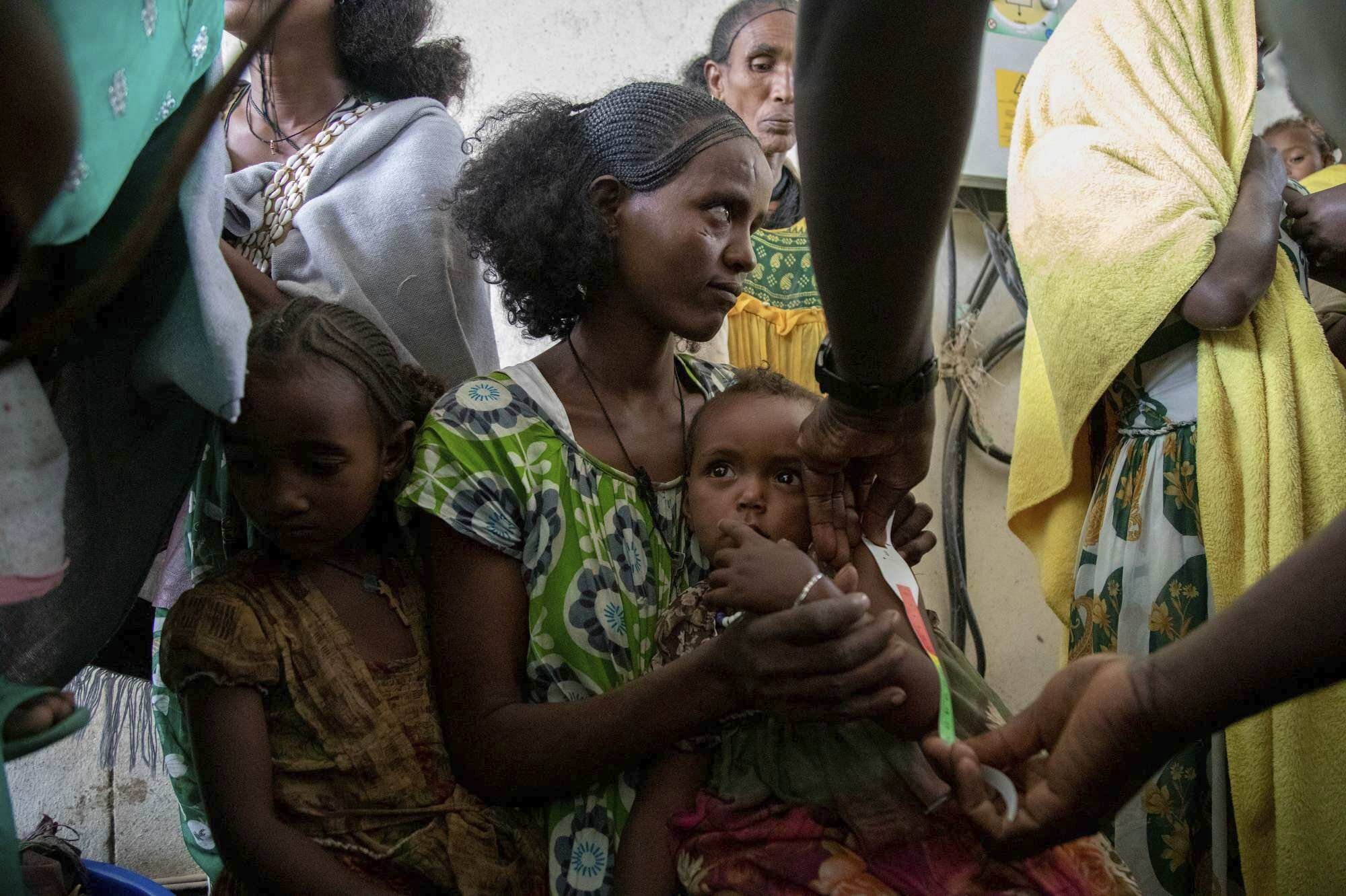
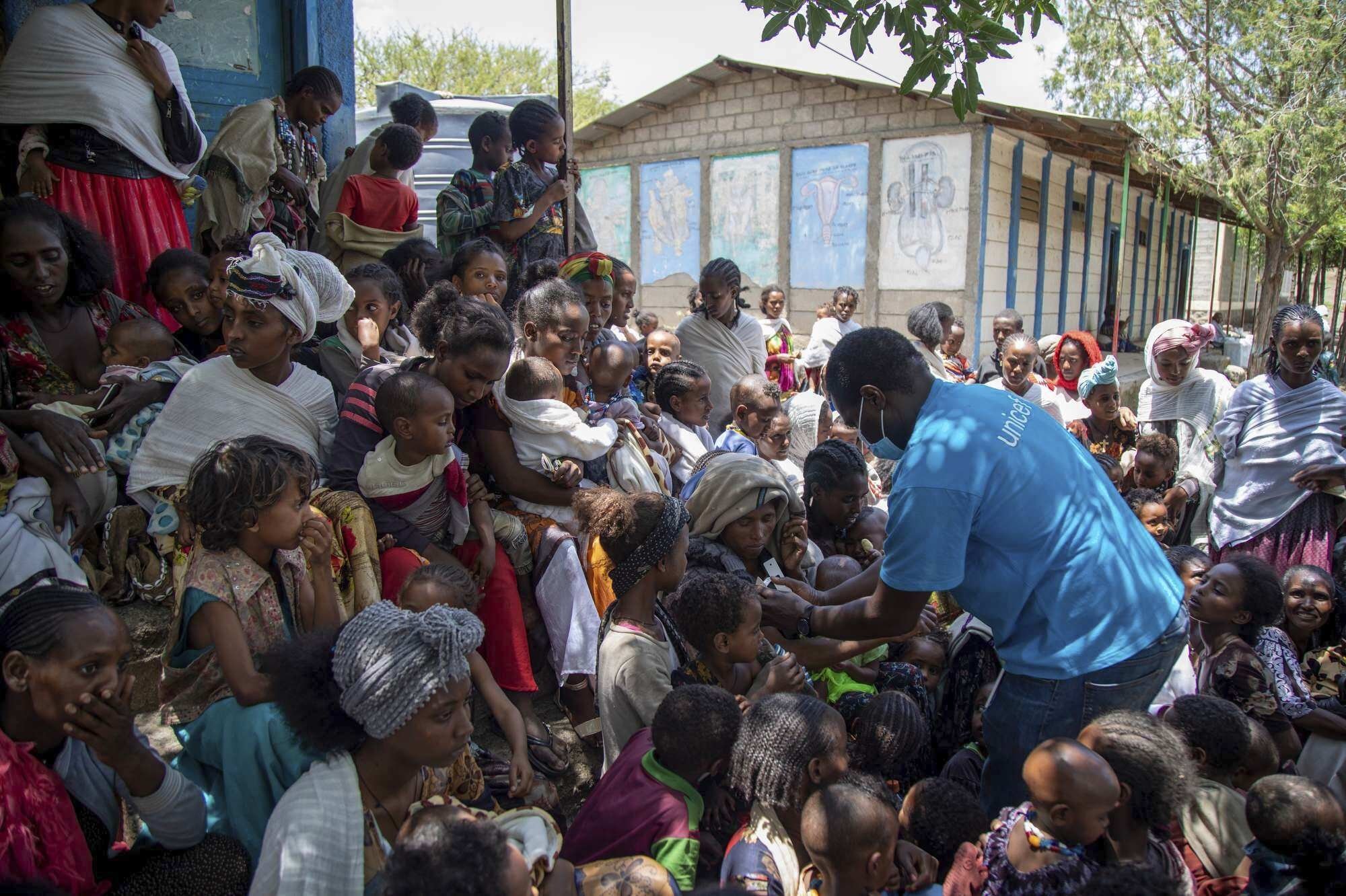
"Currently, there are devastating reports coming from every corner,” the aid group wrote to a donor in August, according to documents shared with the AP. In April, the group wrote that 22 people in one subdistrict had starved to death. In August, another staffer visited a community in central Tigray and wrote that some people "are eating only green leaves for days.”
One aid worker who recently visited Tigray described the effects of the deprivation: Some toilets in crowded camps for the displaced are overflowing without the cash to pay for their cleaning, leaving thousands of people vulnerable to outbreaks of disease. People who ate three meals a day now eat only one. Camp residents rely on the charity of host communities who often struggle to feed themselves.
"It’s worse than subsistence," the aid worker said. At least 150 people starved to death in August, including in camps for displaced people, the Tigray External Affairs Office has alleged. The International Organization for Migration (IOM), the U.N. agency which supports the camps, said: "We, unfortunately, are not able to speak on this topic.”
Food security experts months ago estimated that 400,000 people in Tigray face famine conditions, more than the rest of the world combined. But the blockade means experts cannot collect needed data to make a formal declaration of famine. Such a declaration would be deeply embarrassing for Ethiopia, which in the 1980s seized the world’s attention with famine so severe, also driven by conflict and government neglect, that some 1 million people died. Now malnutrition rates are near 30% for children under 5, the U.N. World Food Programme said Wednesday, and near 80% for pregnant and breastfeeding women.
As the war spreads, so might the hunger. Tigray forces have entered the neighboring regions of Amhara and Afar in recent weeks, and some residents accuse them of carrying out acts of retaliation, including closing off supply routes. The Tigray forces deny it, saying they aim to pressure Ethiopia's government to lift the blockade. There is little help coming.
The U.N. says at least 100 trucks of aid must reach Tigray every day. But as of Sept. 8, less than 500 had arrived since July. No medical supplies or fuel have been delivered to Tigray in more than a month, the U.S. says, blaming "government harassment,” not the fighting.
On Tuesday, the U.N. issued the first report of its kind showing the number of days remaining before cash or fuel ran out for critical work like treating Tigray’s most severely malnourished. Often, that number was zero.
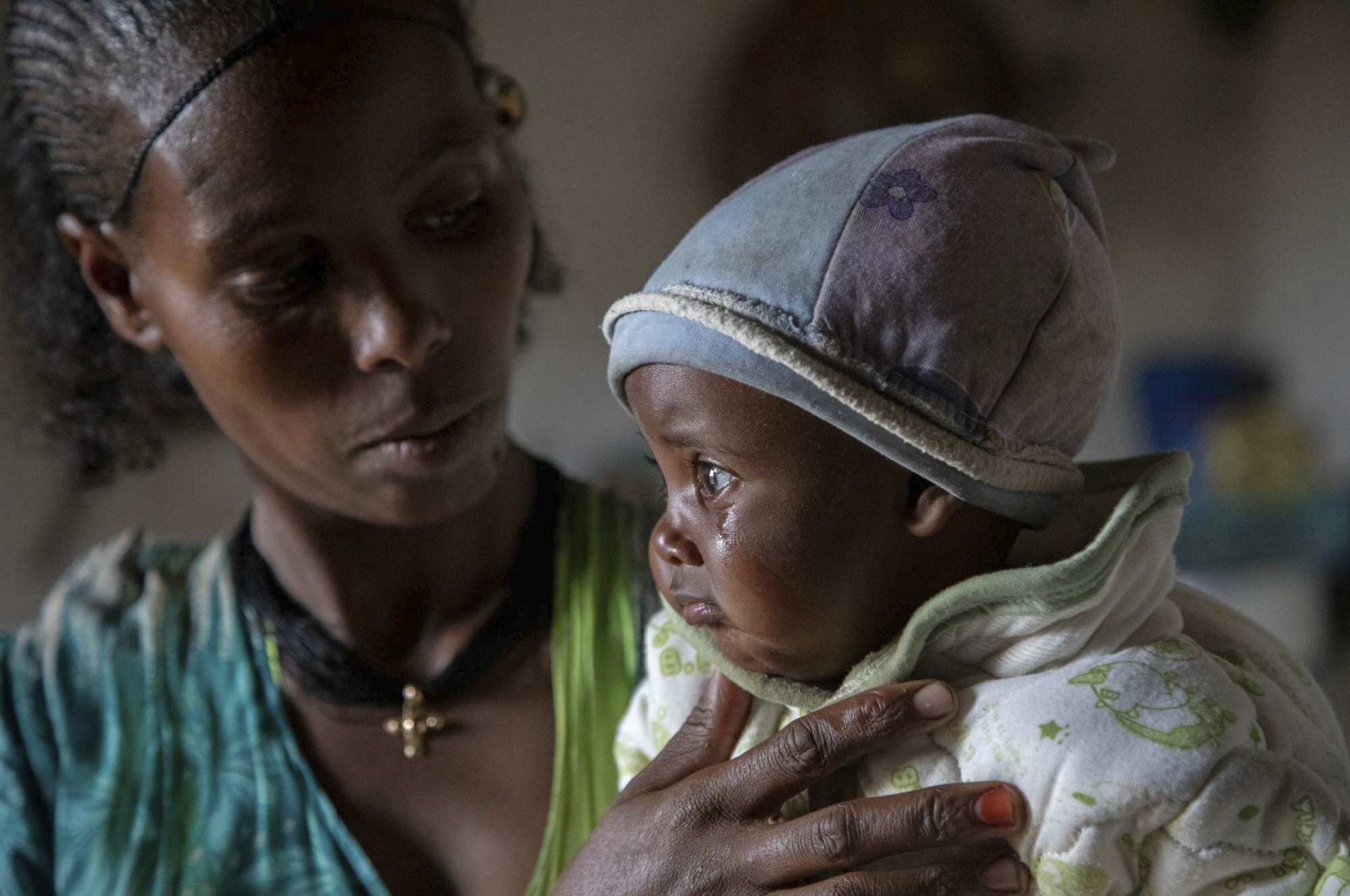
Residents in Ethiopia's blockaded Tigray starve to death
New photographs from the restricted Ethiopian region of Tigray revealed a catastrophic famine gripping the population and causing deaths as the U.S. and...
TPLF moving forward forcing Ethiopian armed forces to withdraw
UN and AU should hold a meeting and have Ethiopia commit to a UN line, and the same with Tigray. And start a bombing run to make them pull back target would be all vehicles used for military purpose. With drone technology it should be possible to make them obey.
Ethiopia uses MAM-L against Tigray forces.
Confirms that TB2 was exported?
Ethiopia uses MAM-L against Tigray forces.
It seems soConfirms that TB2 was exported?
Abiy: Ethiopia must stop food aid to avoid pressure
BBC Monitoring
The world through its media
Ethiopia's prime minister has been facing increasing global pressure over the war in the northImage caption: Ethiopia's prime minister has been facing increasing global pressure over the war in the north
Ethiopia's Prime Minister Abiy Ahmed says the country needs to stop receiving food aid to avoid foreign pressure on the government, state-owned Ethiopia Television (ETV) has reported.
"If we make sure that this thing called wheat [food aid] does not enter Ethiopia, 70% of Ethiopia's problems will be solved.
"Ethiopia's problem is wheat aid. With wheat aid comes diseases. With wheat aid come many things, many consequences. If we stop it, many of the problems will be solved," Mr Abiy said.
The prime minister was speaking during a visit to a wheat farm in Oromia region.
Ethiopia, which is among major aid recipient countries, is facing increasing pressure from some Western governments over the conflict in its northern Tigray region, where millions are at risk of starvation.

World News - BBC News
Get the latest BBC World News: international news, features and analysis from Africa, the Asia-Pacific, Europe, Latin America, the Middle East, South Asia, and the United States and Canada.
Can't see the tweet
Ethiopia uses MAM-L against Tigray forces.
But I tried searching for it and got an article from august.
Tigray: A major new Ethiopia-Eritrea offensive using Turkish drones predicted
AUGUST 25, 2021 ERITREA HUB ETHIOPIA, NEWS, TIGRAYThe Horn analyst, Rashid Abdi has shared this information via Tweets
“Major escalation in Tigray war looming:
- Plane said carrying drone munitions from Turkey due in Addis
- Big Eritrean troop movements along Adigrat, Humera fronts
- PM Abiy made secret trip to Asmara Aug 18 to fine-tune plans for new joint offensive to retake Tigray”

A few weeks ago, there were claims that Turkey has provided Ethiopia combat drones to be used in the Tigray conflict.
The Turkish embassy in Addis Ababa immediately rejected the allegations saying it was fabricated. But this now seems highly likely.
“Turkey’s direct military involvement in 2 conflicts (Libya and Armenia-Azerbaijan) decisively changed the course of the wars,” wrote Rashid Abdi. “Will its supply of lethal drones to Ethiopia shift tide in favour of Addis in Tigray war?”
“An Ethiopian Airlines plane using a disguised call sign picked weapons from military airport in Corlu, Turkey. The plane flew back overnight to Addis. Cargo mainly drone munitions (Mam-L High explosive, anti-armor warhead)”
This is what drones can do to armoured vehicles. Look at the small hole in the top, which put the vehicle out of action.

Rashid Abdi retweeted this information about flights


Tigray: A major new Ethiopia-Eritrea offensive using Turkish drones predicted - Eritrea Hub
The Horn analyst, Rashid Abdi has shared this information via Tweets “Major escalation in Tigray war looming: Plane said carrying...
eritreahub.org
Intense fighting in Ethiopia's Amhara region continues
Kalkidan YibeltalBBC News, Addis Ababa
In Ethiopia, intense fighting is reported to be continuing around the cities of Dessie and Kombolcha in Amhara state between the Tigrayan rebels and the Ethiopian army with its allies.
Dessie is home to tens of thousands of internally displaced people who fled their homes as the war expanded to Tigray’s southern neighbour.
Kombolcha, on the other hand, is an industrial hub, home to the area’s main airport.
Meanwhile air strikes have once again been reported in the Tigrayan capital Mekelle.
The government’s communications office said the targets were parts of Mesfin Engineering, an industrial plant that was also hit by air strikes last week.
Rebel forces have not responded to the claim about the targets but senior figure Getachew Reda tweeted confirming the air raids in the city adding their "air defence unit" was "engaging enemy jets".

World News - BBC News
Get the latest BBC World News: international news, features and analysis from Africa, the Asia-Pacific, Europe, Latin America, the Middle East, South Asia, and the United States and Canada.
Ethiopia strikes Tigray's Mekele, kills 6, including children
BY AGENCIES
ISTANBUL AFRICAOCT 28, 2021 3:50 PM GMT+3
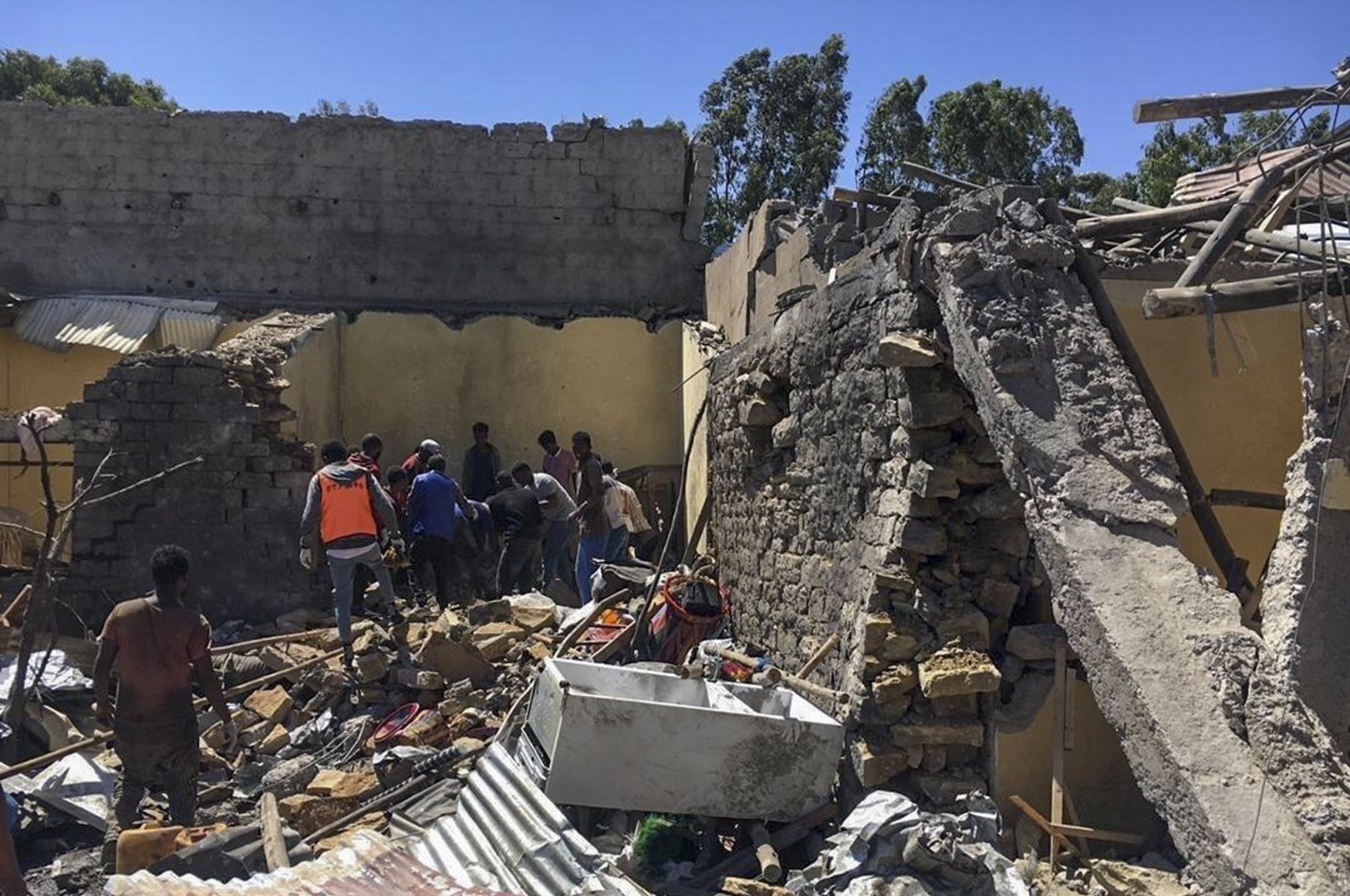
Residents sift through rubble from a destroyed building at the scene of an airstrike in Mekele, in the Tigray region of northern Ethiopia, Oct. 28, 2021. (AP Photo)
An Ethiopian airstrike hit the capital of the northern region of Tigray on Thursday, with Tigrayan forces saying it killed six civilians in their homes, while the government said the strike hit a factory where military equipment was stored.
Tigray spokesperson Nahusenay Belay denied that the airstrike hit a military target and said it struck a "civilian residence," killing six people and wounding more than 20. Three children were among the dead, he said, according to The Associated Press (AP).
A doctor told Reuters he saw six people pulled out of the rubble from the bombing, and that he could not tell if they were alive or dead. He said the strike hit the residential Kebele 5 area. Tigrayan television screened pictures of Red Cross workers at the site of collapsed brick structures with corrugated iron roofs. Blankets and kettles can be seen among bloodstained wreckage. At one point, gloved volunteers hastily cover a body part with a sheet.
The government said in a statement that the airstrike hit Mekele and destroyed the other part of Mesfin Industrial Engineering PLC, a factory complex bombed last week, which it said the Tigray People's Liberation Front (TPLF) was using to maintain military equipment. But TPLF spokesperson Getachew Reda told Reuters that the airstrike hit Kebele 05 and that three people were killed, several other injured and three houses destroyed.
Asked for a comment on the alleged civilian deaths, government spokesperson Legesse Tulu replied in a text message: "There is not any intended and deliberate harm on civilians and their properties. The air strike successfully hit its target."
The central government of Prime Minister Abiy Ahmed in Addis Ababa has been fighting the Tigrayan forces, led by the TPLF, for nearly a year. The conflict has killed thousands of people and displaced more than 2 million.
The TPLF now controls most of Tigray and parts of the two neighboring regions. Thursday's strike is the latest in a campaign of aerial bombardments that the government began on Oct. 18. The air offensive accompanies intensified fighting in two neighboring northern regions – Afar and Amhara – where the military is trying to recover territory taken by the TPLF.
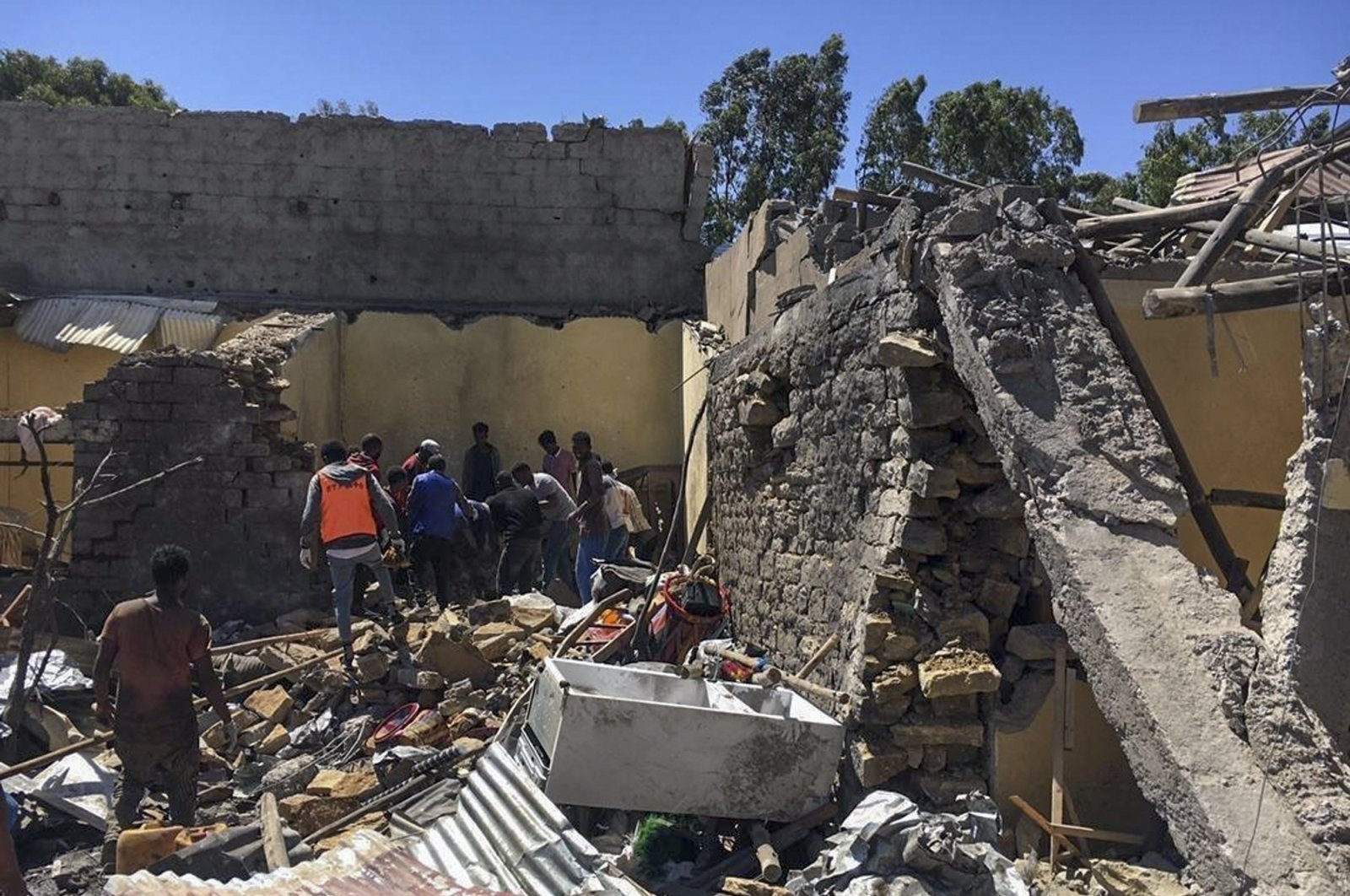
Ethiopia strikes Tigray's Mekele, kills 6, including children
An Ethiopian airstrike hit the capital of the northern region of Tigray on Thursday, with Tigrayan forces saying it killed six civilians in their homes,...





